
Lenovo's refreshed ThinkPad X1 Tablet is back in its third generation with some serious changes, including a 3K touch display, two Thunderbolt 3 ports, and a better kickstand design. This is a serious 2-in-1 device, and while it's more of a business-oriented laptop, it remains in competition with Microsoft's Surface Pro. If you're in the market for a new 2-in-1, both of these are likely on your radar. Let's break things down to help you decide which is best suited for your needs.
ThinkPad X1 Tablet vs. Surface Pro tech specs
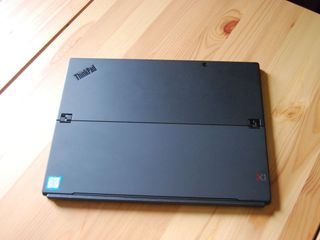
| Category | ThinkPad X1 Tablet | Surface Pro |
|---|---|---|
| Processor | 8th Gen Intel Core i5-8250U8th Gen Intel Core i7-8650U | 7th Gen Intel Core m3-7Y307th Gen Intel Core i5-7300U7th Gen Intel Core i7-7660U |
| Display size | 13-inchTouch | 12.3-inchTouch |
| Display resolution | 3,000 x 2,0003:2 aspect ratio | 2,736 x 1,8243:2 aspect ratio |
| RAM | 8GB, 16GB DDR3 | 4GB, 8GB, 16GB DDR3 |
| Graphics | Intel UHD Graphics 620 | Intel HD Graphics 615 (m3)Intel HD Graphics 620 (i5)Intel Iris Plus Graphics 640 (i7) |
| Storage | 256GB, 512GB, 1TB PCIe SSD | 128GB, 256GB, 512GB, 1TB PCIe SSD |
| Windows Hello | Fingerprint readerIR camera (optional) | IR camera |
| Pen | ThinkPad Pen Pro | Surface Pen |
| LTE | Optional | Optional |
| Ports | Two Thunderbolt 3Nano SIMmicroSD card reader3.5mm audio | USB-A 3.0microSD card readerMini DisplayPortSurface Connect3.5mm audioNano SIM |
| Battery | 42Wh | 45Wh |
| Dimensions | Tablet: 11.97 in x 8.9 in x 0.35 in(304.1 mm x 226 mm x 8.9 mm)With keyboard: 11.97 in x 8.9 in x 0.59 in(304.1 mm x 226 mm x 15.1 mm) | Tablet: 11.5 in x 7.9 in x 0.33 in(292 mm x 201 mm x 8.5 mm) |
| Weight | Tablet: 1.96 pounds (0.89 kg)With keyboard: 2.8 pounds (1.27 kg) | 1.69 pounds (768 g) to 1.73 pounds (784 g)Type cover: 0.68 pounds (310 g) |
ThinkPad X1 Tablet vs. Surface Pro design and features
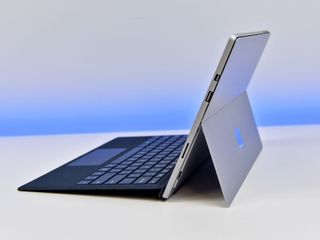
Both the Surface Pro and the ThinkPad X1 Tablet are 2-in-1 devices with removable keyboards and touchpads. The tablet portion of both devices employs essentially the same kickstand design, folding out and back from the middle to prop up the display when it's on a flat surface. The Surface Pro's kickstand rotates 165 degrees, while the X1 Tablet's kickstand rotates at least 170 degrees.
The X1 Tablet has gone through some rigorous durability testing (most ThinkPads do) and its magnesium-aluminum chassis should hold up well. The Surface Pro's magnesium body is likewise sturdy and well built. If you like to get inside your PC and tinker or upgrade, know that the X1 Tablet can be opened relatively easily, while the Surface Pro is pretty much off limits.
Both tablets are about the same thickness, and while the X1 Tablet is slightly larger and heavier overall, it has a larger display. Either device is going to fit easily into a backpack, and even with keyboard and pen along for the ride, both remain highly mobile.
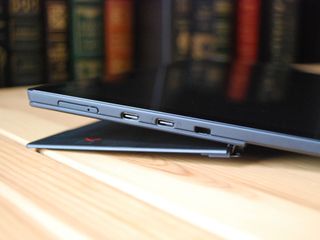
As for ports, the Surface Pro's single USB-A 3.0, Mini DisplayPort, microSD card reader, 3.5mm jack, and Surface Connect offer up some good options, but the X1 Tablet is designed to be future-proof. You're getting two Thunderbolt 3 ports, each with four PCIe lanes, a microSD card reader, Nano SIM, and a 3.5mm audio jack. You don't have as much variety, but those two Thunderbolt 3 ports offer a lot of options for connecting just about any peripheral, including displays or eGPUs. The only downside is that you'll no doubt soon be investing in a USB-C to USB-A adapter.
The Surface Pro comes standard with an IR camera for Windows Hello, and you can grab the same as an optional feature on the X1 Tablet. However, only the latter device comes standard with a fingerprint reader that can also be used with Windows Hello. Both devices feature a TPM security chip, and both are using vPro processors (CPU), except for the Core m3 Surface Pro model.


As for the attachable keyboard and touchpad, the X1 Tablet is treated to a ThinkPad-style typing experience, with cupped keys, plenty of travel, and a soft touch. The Precision touchpad is large, and included are a TrackPoint and physical mouse buttons. The Surface Pro's Type Cover has an Alcantara fabric finish and is available in different colors, offering up a bit more variety than just ThinkPad black. Typing is likewise spot on, and the Precision touchpad, though slightly smaller than the one on the X1 Tablet, is nevertheless solid.
Get the Windows Central Newsletter
All the latest news, reviews, and guides for Windows and Xbox diehards.
Related: 5 Surface Pro keyboards that cost less than Microsoft's Type Covers
Finally, both laptops have optional LTE-A connectivity options. The LTE version of the Surface Pro has a Nano SIM slot but it also has an eSIM, whereas the X1 Tablet seems to only use a Nano SIM slot. If you're interested in eSIM, this could make a big difference.
ThinkPad X1 Tablet vs. Surface Pro display


The new X1 Tablet is still using a 3:2 aspect ratio, but the 13-inch touch display has been upgraded to a 3,000 x 2,000 resolution. It looks absolutely gorgeous with great color reproduction, and while it does have relatively thick bezels, the Surface Pro shares the same trait. Included in the package is Lenovo's ThinkPad Pen Pro (Wacom AES) with 4,096 levels of pressure and tilt support.
The Surface Pro is no slouch either, though the touch display is slightly smaller at 12.3 inches, and it has a lower resolution at 2,736 x 1,824. It uses the same 3:2 aspect ratio, and it also has inking support in the form of the Surface Pen. With 4,096 levels of sensitivity and tilt support, it will likewise deliver an exceptional pen experience.
ThinkPad X1 Tablet vs. Surface Pro performance
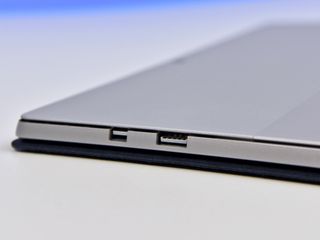
The Surface Pro is using Intel 7th Gen CPUs, while the X1 Tablet has been refreshed with 8th Gen hardware. Those extra cores from the newer CPUs make a noticeable difference in performance, especially when multitasking. Using Geekbench 4.0, the Core i7 Surface Pro received a 4,513 single-core score and a 9,346 multi-core score. The X1 Tablet received a 4,971 single-core score and a 14,289 multi-core score.
Neither laptop has a dedicated GPU, so both rely on an integrated solution. The Iris Plus Graphics in the Surface Pro will outperform the standard UHD Graphics 620 in the X1 Tablet if you're looking at Core i7 models, though the Surface Pro's Core m3 and Core i5 models should fall short of what the Core i5 X1 Tablet model can offer.
Comparing solid-state drives (SSD), the 512GB Surface Pro uses (in most cases) a Samsung PM971 that offers read speeds of 1,284 MB/s and write speeds of 963 MB/s. The X1 Tablet I have for review, however, uses a 512GB Samsung PM981 with read speeds hitting 3,398.1 MB/s and write speeds hitting 1,946.6 MB/s. That's a big difference, but keep in mind manufacturers are beholden to suppliers; if these high-speed drives aren't available, slower alternatives will likely be used.
Overall, the X1 Tablet's more modern hardware should perform better than what the Surface Pro can offer, though both can handle a good deal of work before getting bogged down. A final difference between the two is the battery life. If you want the best, you'll have to go with the Surface Pro, which offers about eight hours or more on a single charge. In my experience, the X1 Tablet lasts between six and seven hours.
ThinkPad X1 Tablet vs. Surface Pro price
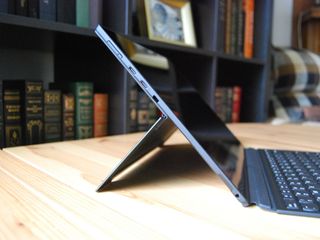
Microsoft does a good job of offering up a "low-cost" model of its laptops, though the hardware is pretty baseline. Starting at about $800, you can get a Surface Pro with a Core m3 CPU, 128GB SSD, and 4GB of RAM. This doesn't include a Type Cover or Surface Pen, which when added brings the total price closer to about $1,060. A model with similar specs to the X1 Tablet I tested costs about $2,460 when you add in the Surface Pen and Type Cover.
The X1 Tablet doesn't have the same lower-cost option, and models start at about $1,270. This price includes the keyboard and touchpad as well as the ThinkPad Pen Pro.
The high-end model with Core i7-8650U CPU, 16GB of RAM, and 512GB PCIe SSD costs about $1,750, nearly $700 less than what you'd pay for a similar Surface Pro package with accessories. Considering you can also choose to go with a cheaper SSD in the X1 Tablet and upgrade yourself later on, that initial price can be brought down even more.
ThinkPad X1 Tablet vs. Surface Pro bottom line
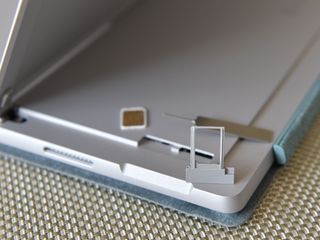
The Surface Pro undeniably has that aura around it that comes from a high-quality, well-built laptop, though it does cost considerably more than similar X1 Tablet models. Still, you get an IR camera, beautiful display, ports that fit better with legacy peripherals, and longer battery life. It's a Surface through and through, and if that's your thing, there's really no alternative.
The X1 Tablet kind of has the same thing going for it, though it has a true ThinkPad vibe, right down to the TrackPoint system. Similarly-spec'd models cost less than the Surface Pro, and accessories are included by default. It has a larger display with a higher resolution, it has newer hardware inside, but its battery doesn't last as long.
This is a tough decision to make, and the final pick will no doubt come down to your personal preference. Either way, you should be happy with your new device, but you can get a lot of laptop for a lot cheaper if you go with the ThinkPad X1 Tablet.
More resources
- Surface Pro with LTE review: Impressive but not for everyone
- Surface Pro 2017 review: A 2-in-1 tablet you'll actually want to use

Cale Hunt brings to Windows Central more than eight years of experience writing about laptops, PCs, accessories, games, and beyond. If it runs Windows or in some way complements the hardware, there’s a good chance he knows about it, has written about it, or is already busy testing it.